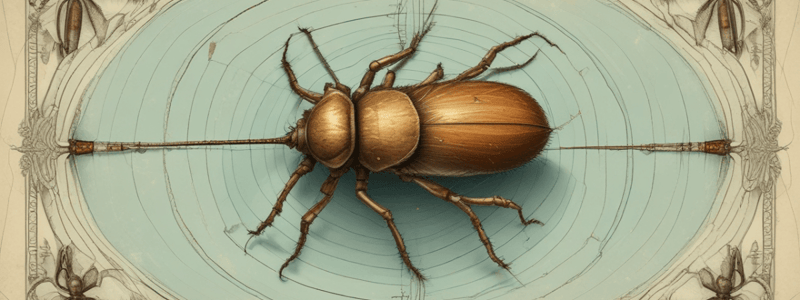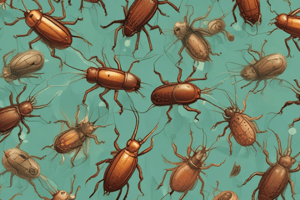Podcast
Questions and Answers
What is the typical duration of the life cycle of two-host ixodid ticks?
What is the typical duration of the life cycle of two-host ixodid ticks?
- Over two years (correct)
- Over a year
- Over four years
- Over three years
What is the stage of the tick life cycle that usually overwinters?
What is the stage of the tick life cycle that usually overwinters?
- Nymphs (correct)
- Adults
- Eggs
- Larvae (correct)
Which host is usually a larger herbivore?
Which host is usually a larger herbivore?
- Third host
- Second host (correct)
- Incidental host
- First host
What is the name of the disease caused by a tick-borne virus of the Bunyaviridae family?
What is the name of the disease caused by a tick-borne virus of the Bunyaviridae family?
What is the stage of the tick life cycle that seeks out the first host?
What is the stage of the tick life cycle that seeks out the first host?
What is the purpose of the female tick dropping off the second host?
What is the purpose of the female tick dropping off the second host?
Can humans serve as both the first and second hosts for ticks with a two-host life cycle?
Can humans serve as both the first and second hosts for ticks with a two-host life cycle?
What is the typical duration of the life cycle of three-host hard ticks?
What is the typical duration of the life cycle of three-host hard ticks?
What is the primary purpose of using permethrin on clothing?
What is the primary purpose of using permethrin on clothing?
What is the most effective way to prevent ticks from attaching to the body while walking in wooded areas?
What is the most effective way to prevent ticks from attaching to the body while walking in wooded areas?
What is the name of the tick-borne encephalitis (TBE) vaccine approved by the U.S. Food and Drug Administration?
What is the name of the tick-borne encephalitis (TBE) vaccine approved by the U.S. Food and Drug Administration?
Why should you avoid sleeping on the floors of mud houses?
Why should you avoid sleeping on the floors of mud houses?
What is the purpose of examining the body frequently for ticks?
What is the purpose of examining the body frequently for ticks?
What is the benefit of using metal beds in areas with high tick infestation?
What is the benefit of using metal beds in areas with high tick infestation?
What is the purpose of tucking trousers into boots or socks?
What is the purpose of tucking trousers into boots or socks?
What is the type of insecticide used to impregnate clothing to prevent tick bites?
What is the type of insecticide used to impregnate clothing to prevent tick bites?
What is a challenge in diagnosing scabies?
What is a challenge in diagnosing scabies?
Why is it important to decontaminate bedding and clothing?
Why is it important to decontaminate bedding and clothing?
What is a common misdiagnosis of scabies?
What is a common misdiagnosis of scabies?
How can scabies be prevented?
How can scabies be prevented?
What is the habitat of Demodex folliculorum?
What is the habitat of Demodex folliculorum?
What is a common symptom of Demodex folliculorum infestation?
What is a common symptom of Demodex folliculorum infestation?
Why is it important to treat all close contacts of an infested person?
Why is it important to treat all close contacts of an infested person?
How long should lindane 1% lotion be left on the skin?
How long should lindane 1% lotion be left on the skin?
What type of organisms do ticks feed on?
What type of organisms do ticks feed on?
What is the primary characteristic of an oblige hematophage?
What is the primary characteristic of an oblige hematophage?
What is the primary way that ticks can infect humans and animals with diseases?
What is the primary way that ticks can infect humans and animals with diseases?
Which of the following diseases is NOT typically spread by ticks?
Which of the following diseases is NOT typically spread by ticks?
What is the main difference between the morphology of hard ticks and soft ticks?
What is the main difference between the morphology of hard ticks and soft ticks?
What is the typical life cycle of most ticks?
What is the typical life cycle of most ticks?
What is the advantage of some species of ticks molting on their host?
What is the advantage of some species of ticks molting on their host?
Why are multiple-host tick species able to exist?
Why are multiple-host tick species able to exist?
What is a common symptom of scabies?
What is a common symptom of scabies?
Where are burrows typically noted in scabies infestations?
Where are burrows typically noted in scabies infestations?
What is the likely representation of erythematous papules in scabies?
What is the likely representation of erythematous papules in scabies?
What is the complication of intense itching in scabies?
What is the complication of intense itching in scabies?
Who is at risk for a severe form of scabies called crusted, or Norwegian, scabies?
Who is at risk for a severe form of scabies called crusted, or Norwegian, scabies?
What is the characteristic of crusted scabies?
What is the characteristic of crusted scabies?
How can persons with crusted scabies transmit scabies?
How can persons with crusted scabies transmit scabies?
How can scabies be confirmed?
How can scabies be confirmed?
Flashcards are hidden until you start studying
Study Notes
Ticks and Tick-Borne Diseases
- Ticks can feed on reptiles, amphibians, and mammals, and can become larger and more visible after feeding on blood.
- Tick bites can transmit diseases caused by bacteria, viruses, and protozoans to humans and animals.
- Some of the diseases spread by ticks include:
- Lyme disease
- Colorado tick fever
- Tularemia
- Powassan virus
- Ehrlichiosis
- Southern tick-associated rash illness (STARI)
- Rocky Mountain spotted fever
- Tick paralysis
- Anaplasmosis
- Spotted fever
- Babesiosis
- Relapsing fever
- Heartland virus
Morphology of Ticks
- Hard ticks have a dorsal shield, which covers the entire dorsal surface in males and only a small portion in females.
- Soft ticks have a leathery body surface and do not have a dorsal shield.
- Mouthparts of ticks are sub-terminally attached and not visible from the dorsal view.
Life Cycle of Ticks
- Most ticks go through four life stages: egg, six-legged larva, eight-legged nymph, and adult.
- Each stage requires a host, and some species can molt on the host.
- Female ticks drop from the host to lay eggs, and the cycle repeats.
- Two-host and three-host ticks have different life cycles that can span over two or three years.
Personal Protections and Prophylactic Measures
- Personal strategies to avoid ticks include:
- Avoiding grassy areas with shrubs
- Wearing long trousers and socks
- Applying permethrin (an insect repellent) to clothing
- Prophylactic measures include:
- Vaccines (e.g. TICOVAC for tick-borne encephalitis)
- Removing attached ticks and examining the body frequently
Clinical Features and Diagnosis of Scabies
- Scabies causes pruritus, burrows, and erythematous papules on the skin.
- Burrows typically appear on the hands, wrists, and genitalia, while erythematous papules are seen on the trunk.
- Scabies can lead to skin sores and bacterial infections.
- Diagnosis can be confirmed through microscopic examination of scrapings from burrows and papules.
Crusted (Norwegian) Scabies
- Crusted scabies is a severe form of scabies that affects immunocompromised, elderly, disabled, or debilitated persons.
- It is characterized by thick crusts of skin containing large numbers of scabies mites and eggs.
- Crusted scabies is highly contagious and can be transmitted indirectly through contaminated items.
Treatment of Scabies
- Treatment involves applying a topical cream (e.g. lindane or permethrin) to the entire body, washed off several hours after application.
- Bedding, clothing, and towels used by infested persons should be decontaminated by washing in hot water and drying in a hot dryer.
Follicle Mites (Demodex folliculorum)
- Follicle mites cause blackhead, pimples, and acne.
- They are more prevalent in those with oily skin.
- Habitat: sebum gland on the skin around the nose and face.
- Larger numbers of Demodex folliculorum mites can cause unwanted symptoms and skin problems.
Studying That Suits You
Use AI to generate personalized quizzes and flashcards to suit your learning preferences.




